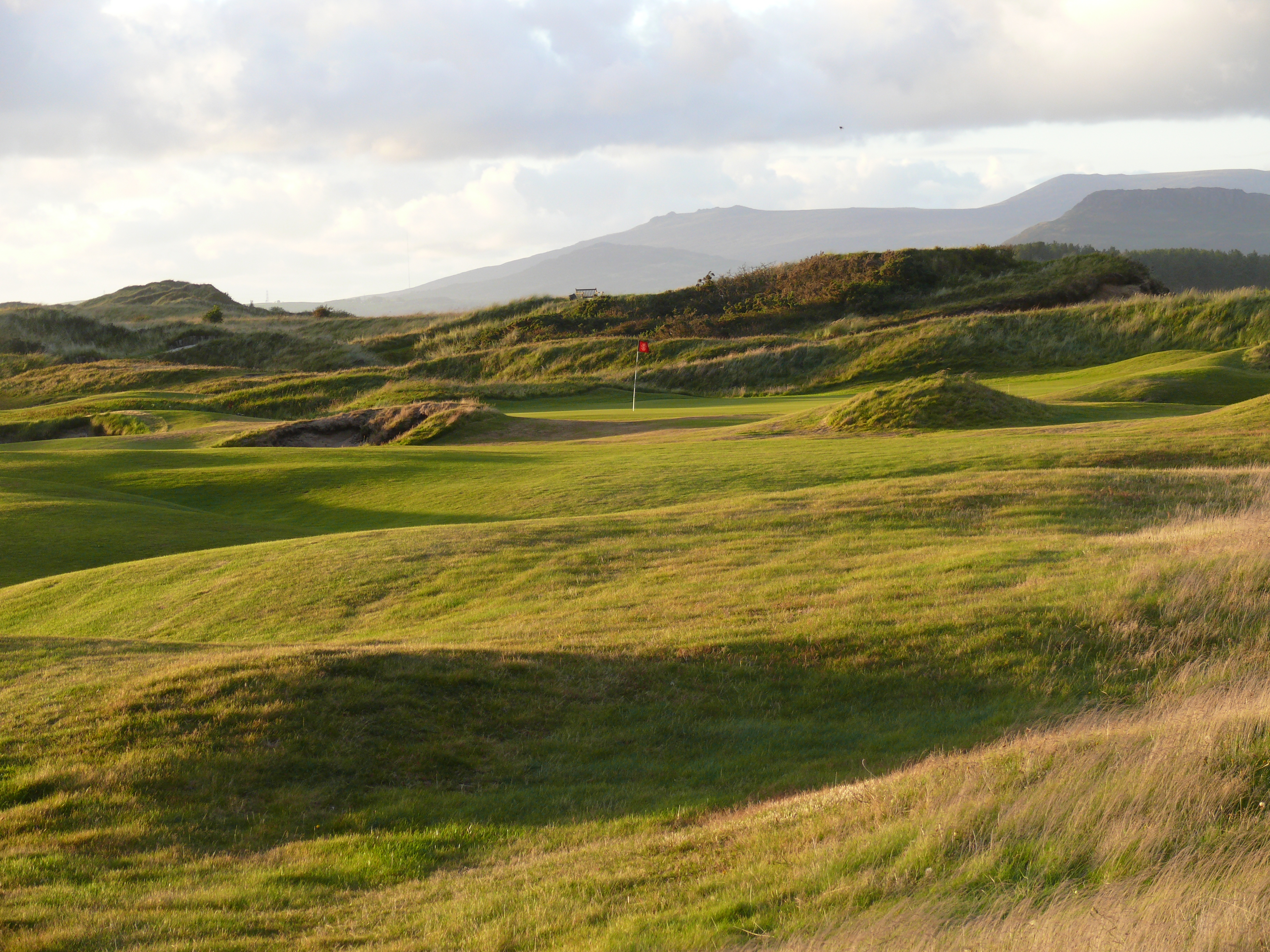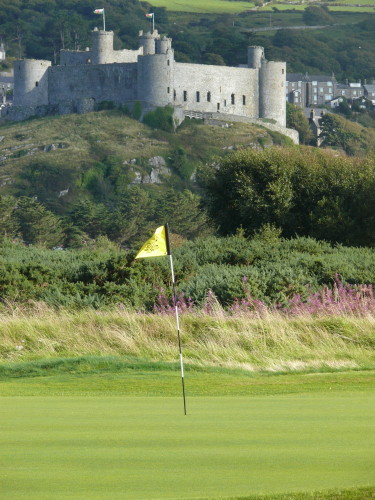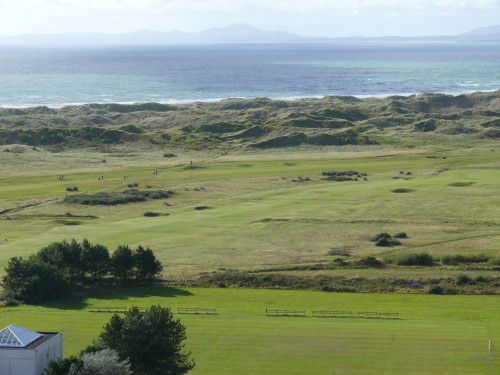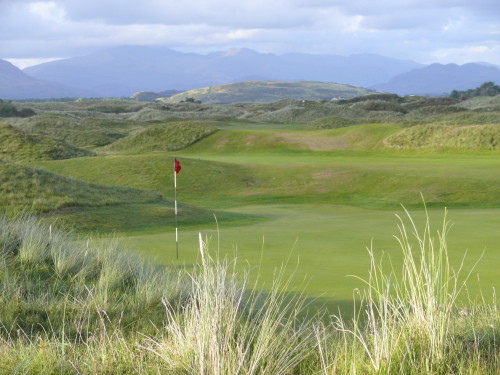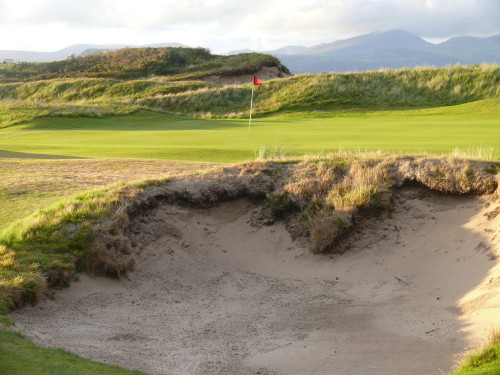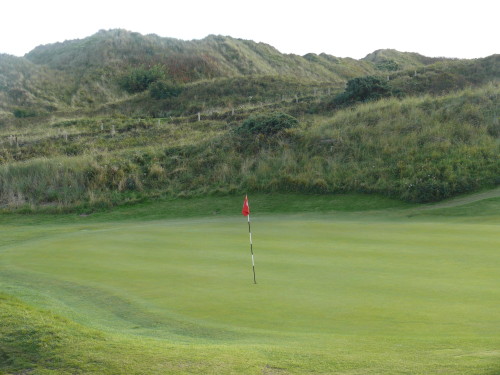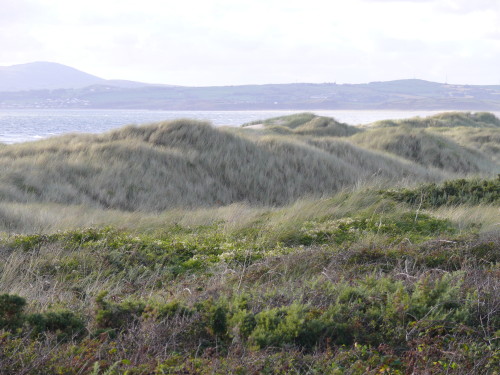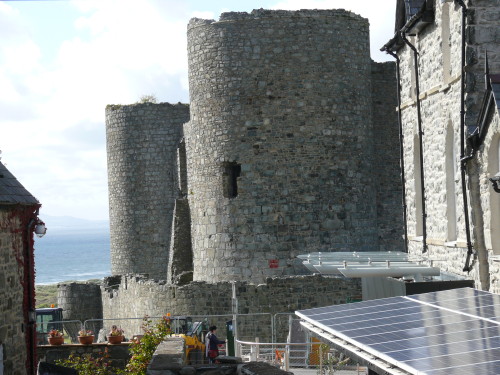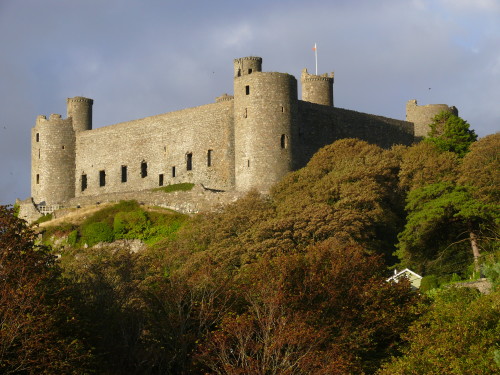Wales, day five: Royal St. David’s Golf Club, royalty indeed
History, Harlech Castle, and a great golf course in Mid Wales
HARLECH, Wales — You play Royal St. David’s Golf Club without seeing the Irish Sea, but you hear it throughout your round, the sound of the waves on Tremadog Bay delivered by the seemingly ever-present wind.
The sea is just over a wide swath of dunes, built up over centuries, and the course is wedged on the flat land between the dunes and the cliffs, at the top of which is Harlech Castle, built starting in 1283 by King Edward I.
When the castle was built, the sea crashed on the rocks beneath it, but the water receded, and now from the castle you can see a championship golf course, an elite course really, one of the crown jewels of Mid Wales golf.
The fifth green at Royal St. David’s Golf Club, overlooked by Harlech Castle, in Mid Wales.
Build Royal St. David’s — or Harlech as it’s known to golfers — today rather than in 1894, and the design would no doubt take it through the dunes to the sea and it would be a celebrated trophy course. Except, Royal St. David’s doesn’t need a trophy to attest to its quality.
“I’m sure Mr. Trump would like to get his hands on us,” assistant professional Stephen Doran said, referring to Donald, and what his millions might create here (if there were no Welsh environmental restrictions, which there are, and they’re strict) .
“Golf 120 years ago was a little bit different. They played on the flat land.”
Royal St. David’s Golf Club, viewed from Harlech Castle, on Tremadog Bay, of the Irish Sea, in Mid Wales.
Royal St. David’s certainly ventures into those imposing dunes, especially over the last five holes, with No.15 considered one of the best holes in golf, playing on a narrow fairway to a green framed in the dunes.
In the book “True Links: An Illustrated Guide to the Glories of the World’s 246 Links Courses” there is a special entry for Royal St. David’s:
“With the 13th-century Harlech Castle towering above the course and the mountains of Snowdonia in the background, Royal St David’s can claim one of the finest locations in links golf.”
According to “True Links,” the course was created to rival St. Andrews and features “a mixture of relatively flat land, rolling fairways, and imposing sand hills; fairways meander through this linksland to greens often created in dells or on higher plateaus … The course is noted for a succession of long par 4 holes and five short holes, and for the expansive size of its greens.”
The 15th green and fairway, a signature hole at Royal St. David’s Golf Club.
In “The 500 World’s Greatest Golf Holes,” there is a long description of No. 15, a 4359-yard par 4:
“Playing into the prevailing wind, the 15th demands two precisely struck shots to reach the green. With Mount Snowden in the distance, the scale and definition of the hole are perfectly balanced with the task at hand. … There are no bunkers here. The hole finds its defense from the sand hills, the wind and a hollow just short of the green. A running approach must negotiate the hollow, and a high, pitched second shot is left to the uncertainties of the Snowdonian wind.”
The 14th green at Royal St. David’s Golf Course in Harlech, North Wales.
The “Royal” designation was bestowed in the 1930s, as King George V was Patron of the course, and the Prince of Wales was captain.
The course bills itself as one of the toughest par 69s in golf; it plays 6,225 yards from the men’s tees and 5,783 yards from the “ladies” tees, where par is 74. Championship tees play 6,629 yards.
When the wind isn’t blowing, the course might not be that tough, as a course record of 60 attests. “Calm day, hit it straight,” and there are scores to be had, Doran said.
The 17th green at Royal St. David’s Golf Club in Harlech, Mid Wales.
The course only has two par 5s, and they come back to back at No. 7 and No. 8. It has five par 3s, including No. 18, and they range in distance from 132 yards from the yellow tees on No. 11 to 209 yards on No. 14. And the par 4s are very tough, the longest 454 yards from the yellows.
The course is laid out so that holes with the wind are followed, almost without exception, by holes against the wind.
It’s a high-quality challenge, and it’s understandable that Royal St. David’s would like to host bigger tournaments, though limited hotel space is a restriction. Still, Doran said, the club is hopeful of one day hosting a Walker Cup, or a Curtis Cup.
On the back nine, Royal St. David’s heads into gnarly dunes in North Wales.
Right now, there are 850 members of the club, only 200 who live locally, and the course attracts 6,000 visitors a year, from the United States and elsewhere, and a greens fee that is a great value for the product — $100 on weekdays, $115 on weekends. For marketing purposes, the course is part of the Snowdonia Golf Coast, with Abersoch, Nefyn & District and Porthmadog.
I played Royal St. David’s on Saturday, thanks to the courtesy of Visit Wales, in the person of Jane Harris, with three Northwest journalists from the Seattle area — Blaine Newnham, the former sports editor and columnist of the Eugene Register-Guard and the longtime columnist for the Seattle Times and author of “America’s St. Andrews” about U.S. Open site Chambers Bay; Tom Cade, senior director of communications for the Pacific Northwest Golf Association and editor of Pacific Northwest Golfer Magazine, who plays to a 2 handicap, and Rob Perry, of Bellevue, Wash., a professional golf photographer who plays to a 3.6.
The view of the coast, from an observation tower at the 16th tee at Royal St. David’s Golf Club in Mid Wales, the only coast view on the course.
It was a great experience. Rain had been forecast, for the first time on our trip, and there were several heavy downpours during the night, which we heard from our lodging at the Castle Cottage Restaurant & Rooms, in view of Harlech Castle. But the rain stopped before we played, and the day was perfect, but the wind certainly a factor.
Royal St. David’s requires good thinking along with good golf shots, allowing for the wind and the dangers of bunkers and rough, grown thick in a wet Wales summer. Perry was again our medalist, with a 78 from the yellow tees.
Finally, I managed to win a match against Newnham in Wales in the daily match-play of former Register-Guard sports columnists, shooting a respectable-for-me 95 with four pars. We played a combination of yellow and red tees — they’re still called “ladies tees” here, the United Kingdom not having embraced the “play it forward” trend in the United States — that added up to a still formidable 5,893 yards for this 19-handicapper. I managed four pars — three of them from the yellow tees — and lost two balls, finding one, bringing my five-day North Wales total to 17 lost, five found.
Sunday, our last stop is Aberdovey. I think I have just enough golf balls left.
Harlech Castle, taken from our room at Castle Cottage, Harlech, Wales.
Harlech Castle, as viewed from Royal St. David’s Golf Club.
